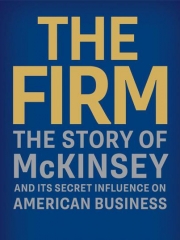The Firm by Duff McDonald
For a consultant, this book is perhaps mandatory reading. But as with all things mandatory, this book is not really mandatory. I decided to read it anyway, since I honestly don’t know much about the consulting industry itself. We talk so much about being knowledgeable in the industries we serve. Yet, I very rarely think about the industry I’m technically in. This becomes all too apparent when people ask me what I do. The definition of consulting I’ve arrived at for now is “injection of talent,” but introducing my job as such doesn’t work too well in small talk.
1) McKinsey was founded in 1926 by James O. McKinsey, a UChicago accounting professor who got a degree in pedagogy.
Timing is everything, and consulting got off to a great start as large conglomerates needed help managing their empires.
2) Alfred Sloan was the president of General Motors who led the company as it surpassed Ford.
Sloan let customers choose between Chevrolets, Pontiacs, Oldsmobiles, Buicks, and Cadillacs.
3) Armour & Company, one of the largest meatpackers in the country, was McKinsey’s first client.
McKinsey helped them rethink budgeting and planning. Contrary to popular belief, consulting has never been glamorous.
4) In 1963, Marvin Bower sold his shares back to the firm at book value instead of selling the firm at market value.
Bower is portrayed as the guy who really defined McKinsey and made it the prestigious consulting firm it continues to be.
5) In 1951, Arch Patton found that worker wages had been rising faster than executive wages.
Although this is not the catalyst for the current sky-high executive pay packages (that, according to Planet Money, stemmed from a Clinton bill that ended up incentivizing stock options), it does show that nothing has to be the way it currently is. Executive pay doesn’t have to be high. Interest rates don’t have to be negative. Inflation doesn’t have to be 0. Economic conditions are artificial.
6) For the first several decades, McKinsey sold a decentralized, multidivisional organizational structure.
The early years of McKinsey focused on organizational work. Then times changed, and McKinsey adapted, shifting its focus to strategy then to content knowledge then to IT.
7) McKinsey did not have a black director until 2005.
Diversity is the buzzword of all buzzwords nowadays. It’s bad now, and it was very bad not too long ago.
8) In Search of Excellence, documenting the “excellent” ways of 43 successful companies, became one of the best-selling business books ever.
This sounds like a terrible book. It’s interesting to note that McKinsey people publishing books is a very real thing. Soft power at its best.
9) Skilling advised Enron to become some sort of a gas bank, by buying gas from producers and selling it to customers.
McKinsey was at the heart of the Enron fiasco, but largely came out clean.
10) Raj Gupta, the managing director, was sentenced to two years in prison for insider trading.
Even more incredible than the Enron escape is McKinsey’s ability to maintain its prestigious brand after this 2012 scandal. Does anyone who considers consulting care at all about this incident? I can’t imagine that anyone would not want to work at McKinsey because of this scandal. Good PR goes a long way.
Three lessons from this book:
1) Be flexible
2) Keep a good reputation
3) Be lucky
Works for McKinsey. Probably works for all of us.
